The “Regionali” class, first Italian-designed protected cruisers
In 1887, Chief Engineer Edoardo Masdea designed a serie of lightweight protected cruisers designed to perform a variety of roles with a limited budget. The first, Umbria, was started in 1888 in Orlando (Leghorn NyD), and as customary was the lead ship namesake.
The others, Lombardia, Etruria, Liguria, Elba and Puglia were started from 1889 to 1893 at Castellamare, Ansaldo (Genoa), and Taranto for the last one, launched in 1901. They were the first protected cruiser designed in Italy as previous ships of this type were designed in Britain, or close copies of the British-designed Giovanni Bausan for the Etna class. However with retrospect, these Regioni class cruisers proved a disappointment, being slow and too lightly protected. Only one really acted as a cruiser during WW1.
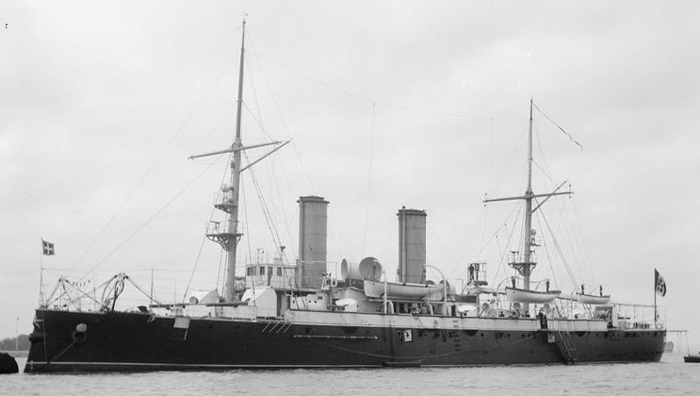
Liguria 1899
Design
Because of the gap between the first and last unit, length of constructions and practices of each yard, the final cruisers varied slightly in their dimensions. Standard size was defined between 80 to 83.2 meters (262 to 273 ft) long (waterline) and up to 88.25 m (289.5 ft) overall with a 12.03-12.72 m (39.5 to 41.7 ft) beam and 4.67-5.35 m (15.3 to 17.6 ft) draft. Displacement also varied from 2,245-2,689 metric tons (2,210-2,647 long) to 2,411-3,110 tonnes when fully load. The original fore and aft sailing rig was seen as obsolete and quickly removed. Two pole masts supporting spotting tops became tjhe norm.
Propulsion
Their propulsion consisted in two horizontal triple-expansion engines fed by four cylindrical water-tube boilers trunked into a pair of funnels. On trials, Umbria reached 19 knots (35 km/h; 22 mph) at 7,400 indicated horsepower (5,500 kW). The others 18.4, 18.3, 18.1 or even 17.9 knots (33.2 km/h; 20.6 mph). Puglia was the fastest at 20 kn (37 km/h; 23 mph). Usual autonomy was about 2,100 nautical miles (3,900 km; 2,400 mi) at 10 knots.
Armament
The ships were initially armed with four 15 cm (5.9 in) L/40 guns on single mounts for and aft, and on each side. Six 12 cm (4.7 in) L/40 guns alternated between them, three per broadside. The light armament however varied per ship. Standard was eight 57 mm (2.2 in) guns, but Lombardia had two more. Umbria had a single 75 mm (3.0 in) gun plus nine 37 mm (1.5 in) guns. Puglia received eight 37 mm guns, Elba six, Liguria, Etruria two, Lombardia none. However two machine guns and two 45 cm (18 in) torpedo tubes were standard. This armament changed during their career.
Protection
It consisted in a 50 mm (2 in) thick deck with a 50 mm thick conning tower was standard but the last ship, Puglia had a 25 mm (0.98 in) thick deck. These were the only armoured part of the ships, and indeed a bit light compared to other nation’s protected cruisers of the time, especially after 1900. They would have been crippled in minutes by any armoured cruiser, which had the same speed of better.
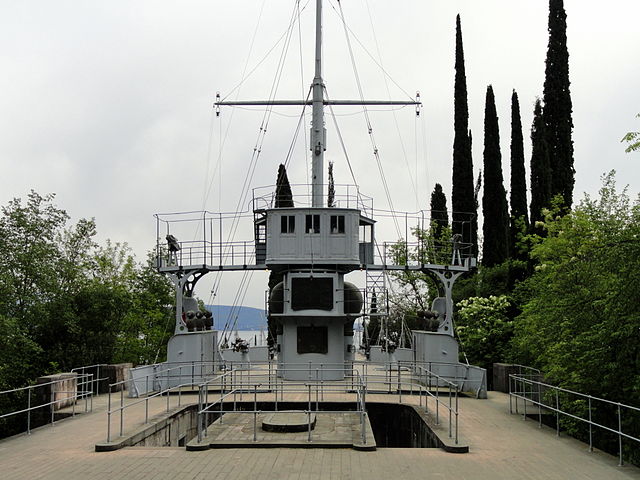
Preserved Puglia’s bow, at Vittoria degli Italiani, Gardone riviera, Garda lake, Brescia.
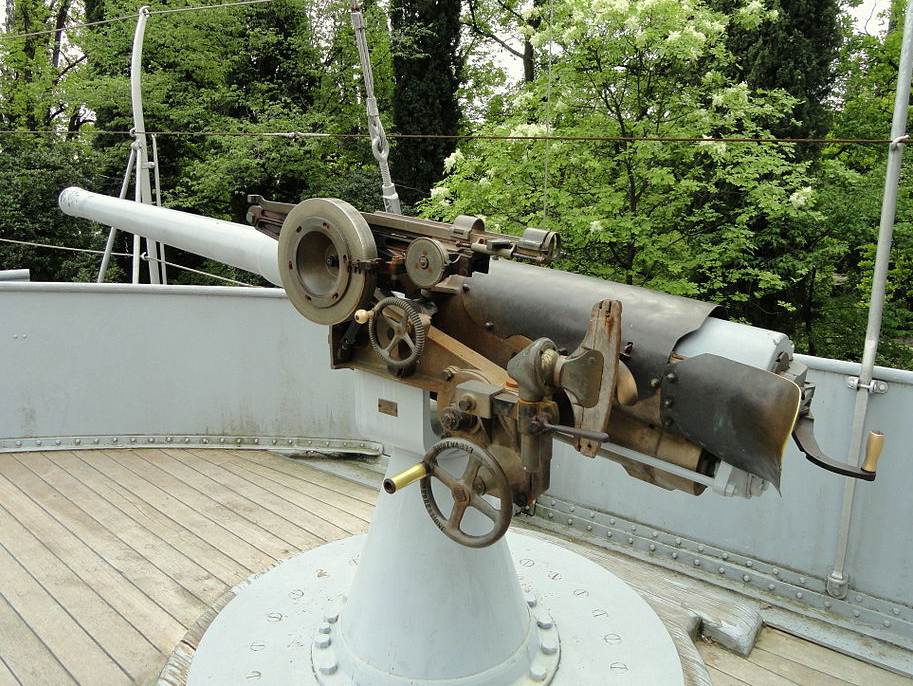
Gun of the Puglia, same location.
The “Regionali class” cruisers were launched between 1890 and 1898, and went into service in 1894-1901. The Puglia, which had been built over eight years, was totally outdated when in service. These cruisers proved too cramped, lacking protection, speed, autonomy. And they were partially disarmed or rearmed.
By 1905 indeed two 15 cm guns were replaced by two 12 cm more modern guns, and the secondary battery went to eight 57 mm guns plus eight 37 mm guns for all ships but the Puglia. The latter indeed had six 57 mm and two 37 mm guns and her torpedo tubes removed. In 1914, Liguria saw her 152 mm (6 in) artillery deposed as well as six 37 mm guns and again in 1917 when she was converted as a minelayer. By then she carried six 120 mm and two 37 mm guns. In 1915, Etruria and Lombardia received six 120 mm guns and six to eight 57 mm plus two 37 mm guns, but retained their torpedo tubes as well as Elba which also had the same armament plus one machine gun.
Career
We will not dig deep into the ships’s career which was a bit dull. These cruisers served at first as cruisers but as signalled above, they were both slow and not well protected. From 1911 to 1916 one was sold, one lost and most were converted. The first decade saw frequent deployments abroad and exercizes in between with the main Italian fleet, deployed as scouts. For example in 1895 Etruria greeted by her presence the ceremonies for the Kaiser Wilhelm Canal.
Lombardia was stationed in South America but saw her crew dying from yellow fever when in Rio de Janeiro. Umbria and Liguria served with the main fleet but Lombardia was stationed in China in 1901 (Elba preceded her) or Italian Somaliland, partiipating in some shelling of Somali rebels. Elba witnessed the Battle of Chemulpo Bay between the Russian and Japanese in February 1904, rescued Russian survivors. The next year she was sent in the USA to represented Italy at the Lewis and Clark Centennial Exposition in Portland. Etruria also visited the United States in 1907 and 1909 celebrations. Both Elba and Liguria observation balloon carriers were supposed to carrying out long range spotting missions to locate naval mines.
Etruria and Liguria took part in the assault on Benghazi (Italo-Turkish War) and covered landings in North Africa. Puglia also raided ottoman ports from East Africa until 1913. One was a diversionary attack which saw the cruiser Piemonte and two destroyers destroying seven Ottoman gunboats at the Battle of Kunfuda Bay. Liguria and Elba also operated in Red Sea to blockade Ottoman ports, punctuated with shelling missions.
Their career was rather long in the end, but not as cruisers: Umbria was sold to Haiti in 1911, renamed Consul Gostrück (other sources tells about Ferrier) but sank at sea because of the inexperience of her new crew. Lombardia became a supply ship for submersibles in 1908. Liguria became in 1911 a transport ship for observation balloons while the Elba was converted in 1914 as a seaplane supply ship and carrier. She was the first dedicatd Italian ship for this purpose. However she soon appeared too small for this use and by 1916, the experimentation ceased.
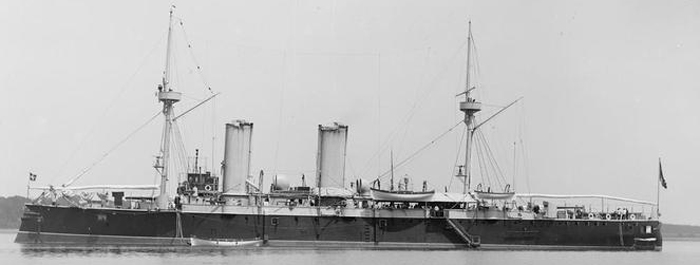
Etruria 1895
Etruria in 1916 was also converted as such but sank at anchor in 13 August 1918, officially due to the accidental explosion of a pair of nearby ammunition barges. In fact this was a deception. She was deliberately blown up in Livorno to fool Austria-Hungary about the existence and effectiveness of her own espionage network, which in reality has been compromised.
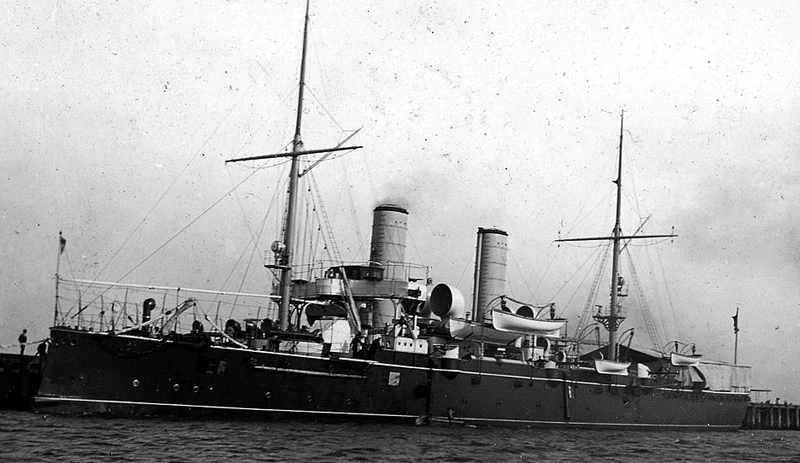
Puglia 1901
Puglia saw her armament reduced to 7 x 76 mm, 1 x 37 mm and 1 x 40 mm AA in July 1916. She was also the most active of all these Regionali class cruisers. indeed in 1915, she crossed off durazzo the cruiser SMS Novara, which spotted her but retired. She probably would have crippled the italian ship. Publia also covered the Serbian Army fighting retreat from Durazzo and dissuaded the Austro-Hungarian Army to chase, by a solid steel barrage. in 1920, Puglia was involved in the civilian riots in Split, the captain and a sailor being murdered by Croat nationalists. She was the last sold, in March 1923 but as whe was dismantled Benito Mussolini decided to preserve the prow section and donate it to the Vittoriale degli italiani museum.
Indeed, Puglia was preserved and can be seen now on lake Garda, Brescia, a precious survivor of this era.
Author’s illustration of the Umbria
Puglia (in 1914) class cruisers specs |
|
| Dimensions | Length 88,20 x 12,10 x 5,45 m (283 x 42 x 19 ft) |
| Displacement | 2250-2690 t, 2410-3110 t FL |
| Crew | 278 |
| Propulsion | 2 shafts, two VTE engines, 4 cyl. boilers, 7677 hp |
| Speed | 19.8 knots () |
| Range | 5,000 nautical miles (9,300 km; 5,800 mi) at 10 knots |
| Armament (Origin 1890s) | 6 x 120 mm, 6 x 57 mm, 2 x 37 mm, 1 MG, 2 x 450 mm TTs. |
| Armor | Decks 76, shields 114, Blockhaus 76 mm |

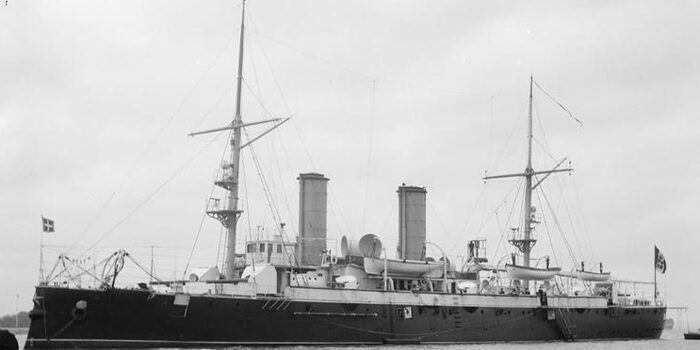

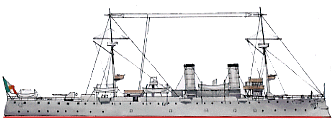
 Latest Facebook Entry -
Latest Facebook Entry -  X(Tweeter) Naval Encyclopedia's deck archive
X(Tweeter) Naval Encyclopedia's deck archive Instagram (@navalencyc)
Instagram (@navalencyc)





 French Navy
French Navy Royal Navy
Royal Navy Russian Navy
Russian Navy Armada Espanola
Armada Espanola Austrian Navy
Austrian Navy K.u.K. Kriegsmarine
K.u.K. Kriegsmarine Dansk Marine
Dansk Marine Nautiko Hellenon
Nautiko Hellenon Koninklije Marine 1870
Koninklije Marine 1870 Marinha do Brasil
Marinha do Brasil Osmanlı Donanması
Osmanlı Donanması Marina Do Peru
Marina Do Peru Marinha do Portugal
Marinha do Portugal Regia Marina 1870
Regia Marina 1870 Nihhon Kaigun 1870
Nihhon Kaigun 1870 Preußische Marine 1870
Preußische Marine 1870 Russkiy Flot 1870
Russkiy Flot 1870 Svenska marinen
Svenska marinen Søværnet
Søværnet Union Navy
Union Navy Confederate Navy
Confederate Navy Armada de Argentina
Armada de Argentina Imperial Chinese Navy
Imperial Chinese Navy Marinha do Portugal
Marinha do Portugal Mexico
Mexico Kaiserliche Marine
Kaiserliche Marine 1898 US Navy
1898 US Navy Sovietskiy Flot
Sovietskiy Flot Royal Canadian Navy
Royal Canadian Navy Royal Australian Navy
Royal Australian Navy RNZN Fleet
RNZN Fleet Chinese Navy 1937
Chinese Navy 1937 Kriegsmarine
Kriegsmarine Chilean Navy
Chilean Navy Danish Navy
Danish Navy Finnish Navy
Finnish Navy Hellenic Navy
Hellenic Navy Polish Navy
Polish Navy Romanian Navy
Romanian Navy Turkish Navy
Turkish Navy Royal Yugoslav Navy
Royal Yugoslav Navy Royal Thai Navy
Royal Thai Navy Minor Navies
Minor Navies Albania
Albania Austria
Austria Belgium
Belgium Columbia
Columbia Costa Rica
Costa Rica Cuba
Cuba Czechoslovakia
Czechoslovakia Dominican Republic
Dominican Republic Haiti
Haiti Hungary
Hungary Honduras
Honduras Estonia
Estonia Iceland
Iceland Eire
Eire Equador
Equador Iran
Iran Iraq
Iraq Latvia
Latvia Liberia
Liberia Lithuania
Lithuania Mandchukuo
Mandchukuo Morocco
Morocco Nicaragua
Nicaragua Persia
Persia San Salvador
San Salvador Sarawak
Sarawak Uruguay
Uruguay Venezuela
Venezuela Zanzibar
Zanzibar Warsaw Pact Navies
Warsaw Pact Navies Bulgaria
Bulgaria Hungary
Hungary

 Bundesmarine
Bundesmarine Dutch Navy
Dutch Navy Hellenic Navy
Hellenic Navy Marina Militare
Marina Militare Yugoslav Navy
Yugoslav Navy Chinese Navy
Chinese Navy Indian Navy
Indian Navy Indonesian Navy
Indonesian Navy JMSDF
JMSDF North Korean Navy
North Korean Navy Pakistani Navy
Pakistani Navy Philippines Navy
Philippines Navy ROKN
ROKN Rep. of Singapore Navy
Rep. of Singapore Navy Taiwanese Navy
Taiwanese Navy IDF Navy
IDF Navy Saudi Navy
Saudi Navy Royal New Zealand Navy
Royal New Zealand Navy Egyptian Navy
Egyptian Navy South African Navy
South African Navy






























 Ukrainian Navy
Ukrainian Navy dbodesign
dbodesign